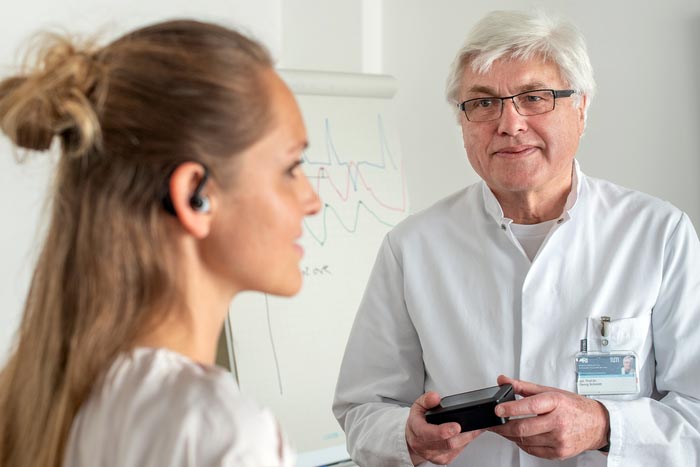Ear sensor enables safe telemedical care for COVID-19 risk patients

With ear sensors, a research team headed by Prof. Dr. Georg Schmidt from TUM's university hospital Klinikum rechts der Isar has continuously monitored the biological values of Covid-19 patients in order to enable convenient home care – and rapid transport to the hospital if necessary.
Credit: Andreas Heddergott / TUM
Telemedical monitoring more reliable than self-assessment.
Using telemedicine, COVID-19 patients can be cared for safely at home – from initial home isolation to recovery or, in case problems arise, admission to hospital. A team from the Technical University of Munich (TUM) has now successfully demonstrated this in a study involving 150 patients with risk factors for a severe progression of the disease.
COVID-19 patients are required to go into home isolation. But this can be dangerous for high-risk patients if they develop a severe progression during isolation. In this case, timely admission to the hospital for treatment can be critical for survival.
Unfortunately, many COVID-19 patients do not immediately notice when their condition starts to deteriorate. The alternative of playing safe by admitting all at-risk patients immediately upon diagnosis would overburden the clinics.
Small effort – large gain in safety
During the recent Corona waves, Georg Schmidt and his team provided telemedical care to more than 150 patients with risk factors for a severe progression of the disease using an ear sensor that is easily worn behind the ear like a hearing aid.
The sensor recorded all important values such as body temperature, heart rate, respiration rate, and oxygen saturation in 15-minute intervals and transmitted the data to the telemedicine center at TUM’s university hospital Klinikum rechts der Isar. There, the team continuously monitored all incoming data. In addition, each participant was called at least once a day to inquire about his or her condition.
Whenever the team noticed a deterioration in the readings, they called the patient. A physician then took a decision on whether hospitalization was indicated. With minimal effort, the team achieved a quality of monitoring quite comparable to that at a hospital.
Great patient satisfaction
Around one in eight participants had to be admitted during the study. Interestingly, most of these patients later stated that they did not themselves realize the degree of deterioration in their condition.
“To our knowledge, this is the first study worldwide to continuously monitor patients in home isolation remotely and to prompt immediate hospitalization in the event of critical health deterioration,” said Prof. Georg Schmidt, head of the Biosignal Processing Group at the Klinikum rechts der Isar.
The study illustrates that COVID-19 risk patients can be monitored effectively using telemedicine, potentially saving valuable resources in future waves of infection. Patients were also very satisfied and felt significantly safer thanks to the continuous monitoring.
###
The study was funded by the TUM University Foundation, the Margarete Ammon Foundation and the Bavarian State Ministry of Science and the Arts. The sensor used by the authors is manufactured by Cosinuss GmbH, a spin-off from the Technical University of Munich.
Journal: PLoS ONE
DOI: 10.1371/journal.pone.0257095
Method of Research: Experimental study
Subject of Research: People
Article Title: Remote monitoring of COVID-19 positive high-risk patients in domestic isolation: A feasibility study
Article Publication Date: 24-Sep-2021
Media Contact
Andreas Battenberg
Technical University of Munich (TUM)
battenberg@zv.tum.de
Office: 49-892-891-0510
Original Source
https://www.tum.de/en/about-tum/news/press-releases/details/36943
Media Contact
All latest news from the category: Medical Engineering
The development of medical equipment, products and technical procedures is characterized by high research and development costs in a variety of fields related to the study of human medicine.
innovations-report provides informative and stimulating reports and articles on topics ranging from imaging processes, cell and tissue techniques, optical techniques, implants, orthopedic aids, clinical and medical office equipment, dialysis systems and x-ray/radiation monitoring devices to endoscopy, ultrasound, surgical techniques, and dental materials.
Newest articles
Faster, more energy-efficient way to manufacture an industrially important chemical
Zirconium combined with silicon nitride enhances the conversion of propane — present in natural gas — needed to create in-demand plastic, polypropylene. Polypropylene is a common type of plastic found…

Energy planning in Ghana as a role model for the world
Improving the resilience of energy systems in the Global South. What criteria should we use to better plan for resilient energy systems? How do socio-economic, technical and climate change related…

Artificial blood vessels could improve heart bypass outcomes
Artificial blood vessels could improve heart bypass outcomes. 3D-printed blood vessels, which closely mimic the properties of human veins, could transform the treatment of cardiovascular diseases. Strong, flexible, gel-like tubes…





















